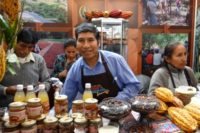LIMA: Salon del Cacao y Chocolate 2014:
The most obvious change in this year’s Salon del Cacao y Chocolate was location.
In just four years, the South American offshoot of the esteemed Paris Salon had outgrown its venue.
This year it took on a new look by moving to the grounds of the lovely Parque de la Reserva in downtown Lima. Magnificent neo-classic water fountains provided a graceful backdrop. The weekend’s many chocolate-themed activities were staged amongst trees in a series of white tents on a lush, emerald lawn. The effect was cool, quiet and spacious.
With seemingly endless room for the event to grow, it is obvious that the Salon is looking to the future. And no wonder. Its popularity mirrors the growing importance of both cacao and chocolate in Peru. Not only did it draw 3,000 more visitors this year than last, it attracted 71 vendors representing growers, producers, chocolatiers and myriad participants in a largely new, and flourishing, chocolate industry. In addition to business round tables, panel discussions and demonstrations, there was everything from innovative manufacturing equipment to art and sculpture. And of course, from roasted beans to finished confection, chocolate could be sampled everywhere.
Chocolatiers and buyers from more than a dozen countries were in attendance. While most came from the United States, Canada, Europe and South America, some traveled from as far away as Australia. While sampling, buying, learning about, understanding and meeting the people behind the business of cacao in Peru, they shared their own experience and expertise. Clay Gordon, whose web site, TheChocolateLife, provides a virtual gathering place for a worldwide conversation focused on cocoa and chocolate, participated in a panel introduced by Joe Whinney of Theo Chocolate in Seattle.
“It is difficult for foreigners to really appreciate what the Salon means to Peruvians,” Gordon said later. “Bringing in visitors from around the world shows the average Peruvian the respect the international market has for Peru’s cacao and chocolate. Great strides are being made, noticeable even from when I was here a year ago.”
Given that Lima also hosts one of the largest food festivals in the world, it was not surprising to find a dedicated food tent where continuous cooking demonstrations were being held. Chris Curtain, owner of Éclat Chocolates in West Chester, Pennsylvania was among the presenters. His partnership with Anthony Bourdain and Eric Ripert to introduce the infamous (and/or celebrated, depending on your perspective) Good & Evil bar made chocolate headlines this past year. Other presenters included Giorgio Demarini of Roselen Chocolates in Lima. He described both the artistic and tasting processes he goes through to produce chocolates that are miniature works of art.
Also on hand was Alain Schneider, from the ChocoMuseo, emphasizing his commitment to educate people in the producing countries on where and how cacao grows by teaching them how fine chocolate is made. With locations in Peru, Nicaragua, Dominican Republic and Guatemala, the museums offer hands-on workshops, making it possible to leave with an artfully wrapped bag of chocolates you made yourself.
On Sunday morning, participants had the opportunity to sit in on a tasting of Peruvian chocolate with the author of The New Taste of Chocolate, Maricel Presilla, owner of Gran Cacao Co. in New Jersey.
She was joined by Rosario Olivas from Peru. Naturally, there was a ready supply of chocolate to showcase different growing regions, processes and varietals.
Santiago Peralta of Picari was there to explain what he looks for in the growing availability of Peruvian beans. Brian Horsley, of Marañón Chocolate shared samples of bars made from pure Nacional cacao beans, thought — until a few years ago — to be extinct.
Horsley lives in a remote Andean valley where the Nacional trees are found, working directly with local farmers to export the beans. Both Horsley and Peralta stressed the value of quality sustainable farming over increased production.
Transitioning from Cocaine to Cacao
But, the real success story at the Lima Salon was not about its new location, high-end chocolate or growing audiences. It was about enormous changes happening in the lives of Peruvian cacao farmers.
Those stories were being told in booths where growers, producers and cooperative members gathered. They hinted of better quality lives, increased production and prosperity, focusing on regions in Peru — still the largest producer of cocaine in the world — where cacao has successfully been introduced as a licit crop to replace coca.
Walking from booth to booth at the Salon, one heard quiet conversations, such as “ we no longer have terrorism in our village” and “now the children go to school” and “last week we shipped our first 50 tons of cacao beans to France.”
Behind such successes are innumerable organizations, as well as the people and money to staff them, working together to effect change. Alongside sectors of the Peruvian government are large organizations — such as the U.S. Agency for International Development (USAID) and NGO’s like TechnoServe — as well as small ones working hand-in-hand locally with newly formed womens’ groups, farm cooperatives and others.
And there are individuals, such as chocolatiers, who are teaching farmers who grow cacao — but have seldom, if ever, had the opportunity to taste fine chocolate — how to make their own.
Such efforts are paying off. At the Salon du Chocolat in Paris last November, Peruvian Vice President Marisol Espinoza accepted, on behalf of the Tumbes growing region, a Cocoa of Excellence Award. It was additionally obvious, while walking the Paris show, that artisan chocolatiers from all over the world are putting Peruvian cacao to exquisite use in a diversity of creative ways.
San Martin: A Success Story
At the close of the Lima Salon, international guests were invited to visit the growing region of San Martin. Until recently, the remote location in the Amazon Basin was a stronghold for the cultivation of cocaine. Today, it is a showcase for a dramatic turn-around that has come about through cacao. It serves as an outstanding example of how people, communities and organizations can work together to effect positive change.
“Truly inspiring,” is how Chris Curtain of Éclat described the opportunity to travel “with such a diverse group of chocolate enthusiasts. Although completely different from my past Peruvian travels, it gave us the opportunity to meet and discuss with the farmers of the larger cooperatives.”
One such group is Mishky Cacao in the Quechua speaking community of Chazuta. Traditionally, it is known for its geometrically hand-painted pottery, the women for their bright floral dress. In 2009, 13 women with limited financial resources sat on the patio of one of their houses and decided to form a group to create a better way of life for their families by promoting chocolate. They started by making drinking chocolate. At the Lima Salon this past July, they invited visitors to sample more than ten different products.
It is difficult to visit Chazuta without enjoying oneself immensely. Greeted by women in traditional dress, balancing handmade pottery on their heads filled to overflowing with colorful flowers, hospitality is offered at every turn. And there is song, because the Mishky women use it to tell their stories. Some of their songs are about women who had to protect themselves against violence, whose children suffered under coca cartels.
Today, they write hopeful songs about chocolate as, “a powerful means to improve their quality of life.”
In 2013, the San Martin region was designated part of Peru’s new Ruta del Cacao. The goal is to promote tourism as well as to foster the domestic consumption of cacao. Hopefully, it will also serve as an example to other communities. There are plans to add other regions to the Cacao Route. We will all be watching to see what happens next.
Cacao in Peru
It is estimated that 96,000 hectares of cacao are planted in Peru, providing the main source of income for 45,000 Peruvian families.
Cacao exports grew 27 percent in Peru last year. In 2013, they totaled $137.5 million. This year $145 million is projected.
While much of the cacao that has been planted in Peru is CCN-51, there is a great deal of emphasis on developing better quality varietals by tapping into the wealth of genetic diversity that is indigenous to the Amazon Basin. As a whole, perhaps 50 percent of the cacao grown in Peru comes from other varieties.
The government of Peru, with the assistance of organizations like USAID and NGO’s like TechnoServe, are hard at work to assist in the turn-around from coca to cacao. The goal in 2014 is 30,000 hectares, 10,000 more than last year when coca production areas fell by 17 percent.
And a look at the past shows they have a reason to believe they’ll be successful in meeting their goals. Between 2008 and 2013, Peruvian cocoa exports grew by 99 percent, and as of May 2014,the growth has been 91 percent reaching more than 50 destination markets around the world, says Minister Magali Silva Velarde-Alvarez.
The value proposition of Peruvian cacao is based on transforming the grains toward more innovative and gourmet presentations as fine chocolate manufacturing. This is evidenced by the 165 percent increase in exports of chocolates in recent years, which are presented now as tastings in emblematic fairs such as Paris Salon Du Chocolat, Summer Fancy Food in USA, Anuga and the largest organic fair, Biofach, both of which are in Germany.
Peruvian organizations involved in the effort include: The Peruvian Export & Tourism Promotion Board (PROMPERÚ), The Department of Agriculture, The Peruvian Cacao Growers Association (APPCACAO), and The Commission for the Development & Life without Drugs (DEVIDA).
















